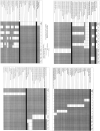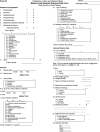Pregnancy, labor, and delivery outcomes of women with and without spinal cord injury
- PMID: 35108166
- PMCID: PMC10114998
- DOI: 10.1080/10790268.2021.2018155
Pregnancy, labor, and delivery outcomes of women with and without spinal cord injury
Abstract
Objectives: Compare outcomes in pregnant women with and without Spinal Cord Injury (SCI).Design: Case study and inception cohort comparison.Setting: Community, primary care/referral center and university practice.Participants: Twenty-eight pregnant women (12 with SCI ( = PW-SCI) and 16 without SCI ( = PW-AB)) were enrolled. Six PW-SCI left study and six completed data collection and were matched, by age, parity, and race, with 12 PW-AB (1:2 ratio, respectively). Final analysis included 18 (78%) subjects.Interventions: Not applicable.Main Outcome Measures: Utilizing standardized, templated medical records (published by NIH/NICHHD and DHHS) and self-report, prospective, longitudinal and retrospective details of pregnancy, labor and delivery experiences/complications were recorded for all women and their neonates. Data collection included vital signs, urinalysis, pregnancy-related conditions/complications (i.e. UTIs, hyperglycemia), and labor, delivery, fetal outcomes. For PW-SCI, demographics, occurrences of autonomic dysreflexia (AD), pressure sores, worsening SCI conditions (i.e. spasticity, bladder spasms, lost independence) were recorded.Results: PW-SCI had statistically greater (P < .05) UTIs than PW-AB (three (50%) to 0 (0%), respectively). One PW-SCI (17%) reported pressure sores and one AD. Three (50%) PW-SCI and 4 (33%) PW-AB experienced a complication at delivery. Newborn mean birth weight (2854 g vs 3578 g; P = 0.12), and length (49.3 vs 45.8 cm; P = 0.32) were lower for PW-SCI than PW-AB. Head circumference was significantly less for PW-SCI than PW-AB (30.3 vs 34.5 cm; P = 0.04).Conclusions: Women with SCI tend to have more complicated courses of pregnancy, labor and delivery and smaller newborns than non-SCI peers. Neonatal head circumference is significantly smaller.
Keywords: Labor; Pregnancy; Reproductive health; Women with spinal cord injury; delivery.
Figures
Similar articles
-
Vaginal delivery is safely achieved in pregnancies complicated by spinal cord injury: a retrospective 25-year observational study of pregnancy outcomes in a national spinal injuries centre.BMC Pregnancy Childbirth. 2020 Jan 29;20(1):56. doi: 10.1186/s12884-020-2752-2. BMC Pregnancy Childbirth. 2020. PMID: 31996150 Free PMC article.
-
Autonomic dysreflexia during urodynamics in children and adolescents with spinal cord injury or severe neurologic disease.J Pediatr Urol. 2015 Feb;11(1):32.e1-4. doi: 10.1016/j.jpurol.2014.08.011. Epub 2014 Oct 8. J Pediatr Urol. 2015. PMID: 25697979
-
A multicenter study of women's self-reported reproductive health after spinal cord injury.Arch Phys Med Rehabil. 1999 Nov;80(11):1420-8. doi: 10.1016/s0003-9993(99)90253-8. Arch Phys Med Rehabil. 1999. PMID: 10569436 Clinical Trial.
-
The impact of spinal cord injury on female sexuality, menstruation and pregnancy: a review of the literature.J Am Paraplegia Soc. 1991 Jul;14(3):122-6. doi: 10.1080/01952307.1991.11735841. J Am Paraplegia Soc. 1991. PMID: 1885948 Review.
-
Obstetric management of the patient with spinal cord injury.Obstet Gynecol Surv. 2003 Oct;58(10):678-87. doi: 10.1097/01.OGX.0000086419.94466.76. Obstet Gynecol Surv. 2003. PMID: 14515065 Review.
Cited by
-
Obstetrical Outcomes in Women With a History of Bladder Augmentation.Health Sci Rep. 2024 Nov 29;7(12):e70222. doi: 10.1002/hsr2.70222. eCollection 2024 Dec. Health Sci Rep. 2024. PMID: 39619083 Free PMC article.
References
-
- National Spinal Cord Injury Statistical Center . 2019. Annual Statistical Report for the Spinal Cord Injury Model Systems. Birmingham, Alabama: University of Alabama at Birmingham; 2020 Aug. Available from https://www.nscisc.uab.edu/public/2019%20Annual%20Report%20-%20Complete%....
-
- Christopher & Dana Reve Foundation: Today’s Care, Tomorrow’s Cure. Stats about paralysis ; 2021 Dec. Available from https://www.christopherreeve.org/living-with-paralysis/stats-about-paral....
-
- Skowronski E, Hartman K.. Obstetric management following traumatic tetraplegia: case series and literature review. Aust N Z J Obstet Gynaecol 2008 Oct;48(5):485–491. - PubMed
-
- Baker ER, Cardenas DD, Benedetti TJ.. Risks associated with pregnancy in spinal cord injured women. Obstet Gynecol 1992;80(3):425–428. - PubMed
Publication types
MeSH terms
LinkOut - more resources
Full Text Sources
Medical



